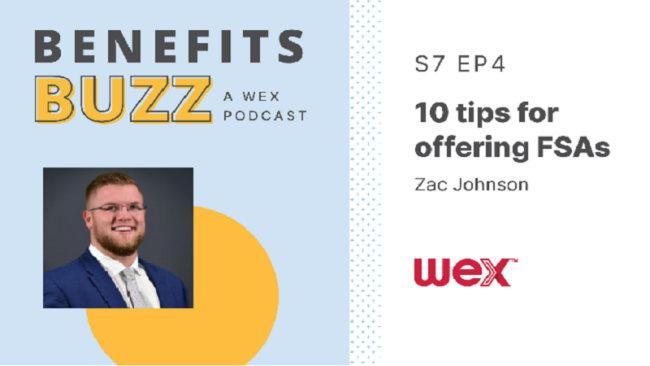Stay connected
Subscribe to our Inside WEX blog and follow us on social media for the insider view on everything WEX, from payments innovation to what it means to be a WEXer.

Flexible spending accounts (FSAs) allow your employees to use pre-tax dollars to cover eligible out-of-pocket healthcare expenses, providing a tax-efficient way to manage medical costs and helping you and your employees save money. But how can you effectively communicate and offer FSAs to your employees? Let’s explore how to offer FSAs at your company, ensuring both compliance and maximum employee engagement. And don’t forget to check out our newest Benefits Buzz podcast episode with Zac Johnson, executive sales director at WEX, below.
Here are the four most common types of FSAs:
Medical FSA: Allows employees to use pre-tax dollars to cover eligible medical expenses,dental, and vision expenses.
Limited medical FSA: Similar to a medical FSA, but can be paired with high-deductible health plans (HDHPs) and health savings accounts (HSAs), covering dental and vision expenses.
Combination FSA: A limited FSA that converts into a medical FSA once the IRS deductible is met.
Dependent care FSA: Lets employees use pre-tax funds for qualified dependent care expenses, including daycare, preschool, and after-school care. Only employees with a legitimate tax-dependent status can use FSAs to cover dependent care expenses.
Educating your employees about FSAs is crucial for their effective use. As Zac Johnson explained in our most recent episode of Benefits Buzz, “When I think of education, I’m thinking of webinars whether it’s live or recorded, one page handouts, short videos, email campaigns, or even pop-ups in the mobile app.” There are many way to educate your employees on FSAs:
Compliance with IRS regulations is also crucial when offering FSAs. But what are the key terms you have to be wary of when offering FSAs?
Selecting the right vendor is critical for smooth administration and employee satisfaction. We know that having trust and confidence in your vendor is important, but what are the key qualities you should be looking for?
Designing an FSA plan that meets your employees’ needs while remaining compliant involves several key steps:
With new emerging tech the FSA game is continuously changing. Here are some of the top emerging tech and trends to look out for in 2024:
Learn more about FSAs and other employee benefits by subscribing to our blog!
The information in this blog post is for educational purposes only. It is not legal or tax advice. For legal or tax advice, you should consult your own legal counsel, tax and investment advisers.
WEX receives compensation from some of the merchants identified in its blog posts. By linking to these products, WEX is not endorsing these products.
Subscribe to our Inside WEX blog and follow us on social media for the insider view on everything WEX, from payments innovation to what it means to be a WEXer.